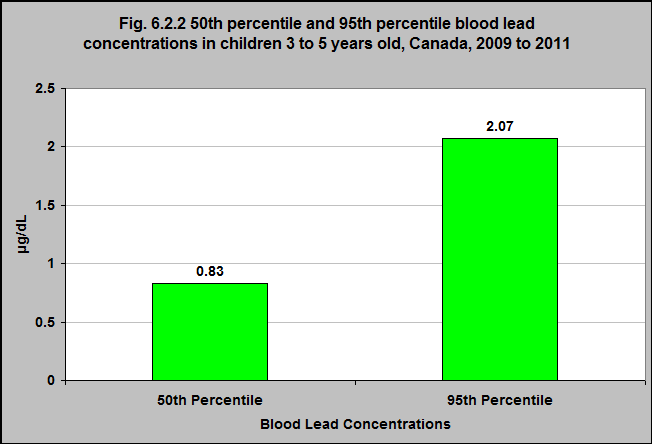50th percentile and 95th percentile blood lead concentrations in children 3 to 5 years old, Canada, 2009 to 2011

Source: CICH graphic created using data adapted from Statistics Canada, Canadian Health Measures Survey, 2007-2009 and 2009-2011 – custom runs.
All children and youth in Canada are exposed to lead. It occurs naturally in the environment in rock and soil, and is present in human-made products.1
The most common route of exposure to lead is in and around the home.
According to the Canadian Health Measures Survey (2009-2011), the blood lead level of every child aged 3 to 5 years was above the limit of detection. We would expect this due to the many sources of lead exposure.
The median concentration was 0.83 µg/dL (meaning 50% of children have blood lead levels above 0.83 µg/dL) and the 95th percentile concentration was 2.07 µg/dL (meaning 5% of children have blood lead levels above 2.07 µg/dL).
The values are slightly lower in girls than boys2
Younger children have higher blood lead concentrations than do older children as they generally spend more time playing in soil and have a greater tendency to put objects that may contain lead in their mouths, such as toys. Childhood blood lead levels generally peak between the ages of 1 to 3 years old for these reasons.3
1Health Canada. Environmental and Workplace Health: Lead. (2013) http://www.hc-sc.gc.ca/ewh-semt/contaminants/lead-plomb/index-eng.php– accessed March 12th 2017.
2Statistics Canada, Canadian Health Measures Survey, 2007-2009 and 2009-2011 – custom runs.
3Health Canada. 2013. Final Human Health State of the Science Report on Lead. http://www.hc-sc.gc.ca/ewh-semt/alt_formats/pdf/pubs/contaminants/dhhssrl-rpecscepsh/dhhssrl-rpecscepsh-eng.pdf– accessed March 12th, 2017.
Implications
Lead is one of the most extensively researched toxins and has been linked to many adverse health and behavioural outcomes.
With adverse effects occurring for some children and youth at blood lead concentrations as low as 1 to 2 µg/dL, many 3 to 18 year olds in Canada are at risk. Measures should be taken to ensure that the collective population of children’s exposure to lead is limited. Children’s blood lead levels should continue to be monitored and lowered over time.3
